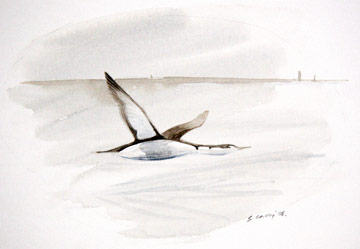Red-throated Diver (Gavia stellata)

Red-throated Diver © Ray Scally
Red-throated Divers mostly spend their winters in the open sea, where they find their food of sandeels, crustaceans, sprats and other fish, so shore-based observations can only sporadically hint at their true presence and numbers. Aerial survey work since 2000/ 01, triggered by research and proposals for offshore windfarms, has shown that there may be 1,200 to 1,500 divers in Liverpool Bay in winter, nearly all of them Red-throated Divers (Banks et al 2006, Musgrove et al 2007). As a result of these findings of internationally important numbers, all of the significant areas of Liverpool Bay, including those off the North Wirral, are now being considered as a marine Special Protection Area for divers and Common Scoters. Almost all of the Red-throated Divers are in waters up to 10-metre deep, this contour stretching about 10 km offshore from Anglesey to the Fylde. Divers are most frequently found off the Welsh coast west of Abergele, but another regularly used spot is about 6 km northwest of Hoylake (Webb et al 2004). Has the offshore limit of the Cheshire and Wirral ornithological recording area ever been defined?
The origins of those in Liverpool Bay are unknown, but Red-throated Divers from a wide range of breeding areas appear to mix in winter around the coasts of Britain and Ireland. Ringed birds from Finland and Sweden have been found in the Irish Sea, and birds from the east and west coasts of Greenland have reached the North Sea off southeast England. Birds from Orkney and Shetland mostly winter at sea off Scotland and Ireland; some immatures, which migrate farthest, have been found off Finistère in France, but it is not known if they move through the Irish Sea on their way (Migration Atlas).
This Atlas map shows a typical picture of the species’ records in recent years, with all birds at or near the north Wirral coast. Most records are of single birds, or a few together, but each winter larger flocks were counted off Hilbre (SJ18Z), with maxima of 50, 60 and 17 reported in the three years of this Atlas. A flock of 27 was on East Hoyle Bank (SJ29A) in the first winter. Mersey records are unusual, and the dot for the New Brighton tetrad (SJ39C) owes its inclusion to a flock of four birds, seen from Seaforth on the Liverpool side, flying out of the river mouth during strong northwesterly winds on the extraordinary seabird day of 9 December 2006.
This has probably always been the commonest diver in the county, although records increased greatly during the 20th century. Coward (1910) called it ‘a wanderer to Cheshire waters in winter’ but knew of few records, while Bell’s summary was that considerable numbers were sometimes seen between autumn and spring (Bell 1962). The largest numbers are recorded after northwesterly gales, with the highest daily count of 125 logged at Hilbre on 2 January 1965 (Craggs 1982). The annual county bird reports show most sightings from Hilbre, with other records from Red Rocks and Hoylake. Winter counts for winters from 1981/ 82 onwards vary from maxima of four in 1981/ 82 to a peak of 67 in 1989/ 90 when 67 flew west past Red Rocks on 28 January. Red-throated Divers are seldom found inland in winter, with the last records in 1995/ 96 including two that showed that birds can subsist on our meres and rivers, one staying at Rostherne and Tatton Park from 4 to 20 January and it, or another, living at the Weaver Bend from 27 February to 25 June (CWBRs).
Sponsored by Derek Pike

